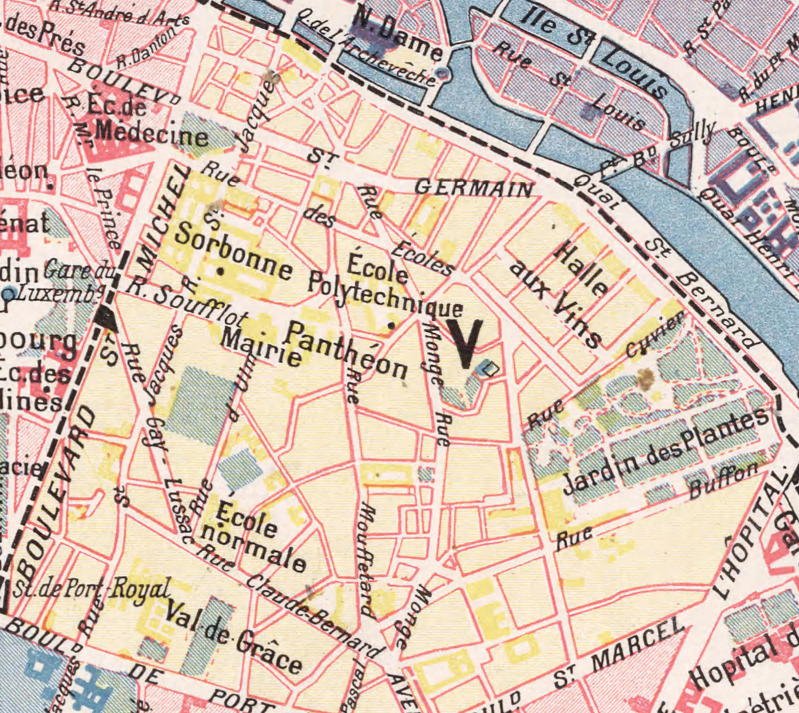5th Arrondissement

Introduction: Known as the Latin Quarter, this fabled neighborhood takes its name from the Sorbonne, where Latin was the common tongue for all students during the Middle Ages. The neighborhood has the feel of a small village and students mix freely with professionals in its winding streets. The rue Mouffetard is a primary artery where shops, international restaurants and student bars and cafés are found.
Situated on the left bank of the River Seine, it is one of the central arrondissements of the capital. The arrondissement is notable for being the location of the Quartier Latin, a district dominated by universities, colleges, and prestigious high schools.
The 5th arrondissement is also one of the oldest districts of the city, dating back to ancient times. Traces of the area's past survive in such sites as the Arènes de Lutèce, a Roman amphitheatre, and the Thermes de Cluny, a Roman thermae.The Eiffel Tower, the Musée d'Orsay, the Rodin Museum and the market street, Rue Cler can be found here. This very wealthy district is also known for being the home of foreign embassies and many international residents.
the Settite Jean-Batiste de Montrond and his friend Veronique d'Orleans live in this quarter. Their basement quarters are near the center of the Latin quarter in the area of the Halle Aux Vin market. There are several buildings here with both rooms and storage in them. Jean Batiste secured rooms beneath this are to live.
PLaces of Importance
- -- Arnaud's Hôtel Particulier -- {La Dame: Carla Gagnon}
- -- Arènes de Lutèce -- The Arènes de Lutèce are among the most important remains from the Gallo-Roman era in Paris (known in antiquity as Lutetia, or Lutèce in French), together with the Thermes de Cluny. Lying in what is now the Latin Quarter, this amphitheater could once seat 15,000 people, and was used to present gladiatorial combats.
- -- Bibliothèque Sainte-Geneviève
- -- Centre de la Mer et des Eaux -- Est.1911 (Construction starts in 1905, opened 1906)
- -- École Normale Supérieure
- -- Fontaine Saint-Michel -- is a monumental fountain located in Place Saint-Michel. It was constructed in 1858–1860 during the French Second Empire by the architect Gabriel Davioud.
- -- Hôtel Lutetia -- New Hotel (circa 1904)
- -- Jardin des plantes de Paris -- is the main botanical garden in France.
- -- Maison des Pécheurs -- A small novel waxwork (recently opened)
- -- Montagne Sainte-Geneviève -- is a hill overlooking the left Bank of the Seine.
- -- Val de Grace Hospital --
- -- Pantheon, Paris --
- -- Ménagerie, le zoo du Jardin des Plantes --
- -- Musée des Collections Historiques de la Préfecture de Police -- is a museum of police history in Paris. Est.1900 (for the Exposition Universelle)
- -- Musée national du Moyen Âge -- formerly Musée de Cluny (French pronunciation: [myze də klyni]), officially known as the Musée national du Moyen Âge – Thermes et hôtel de Cluny ("National Museum of the Middle Ages – Cluny thermal baths and mansion"), is a museum in Paris, France. It is located in the 5th arrondissement at 6 Place Paul-Painlevé, south of the Boulevard Saint-Germain, between the Boulevard Saint-Michel and the Rue Saint-Jacques.
- -- Latin Quarter of Paris -- The Latin Quarter of Paris (French: Quartier latin) is an area in the 5th and the 6th arrondissements of Paris. It is situated on the left bank of the Seine, around the Sorbonne.
- -- Place de la Contrascarpe -- This lies within the Latin quarter of the city. Fra'Raymond operates here.
- -- Rose de Minuit -- Restaurant / Tavern (1904) -- Underworld meeting place.
Holy Ground of the 5th Arrondissement
- -- Église de Saint-Nicolas-du-Chardonnet -- {La Dame: Carla Gagnon}
- -- Église de Val de Grâce --
- -- Eglise de Saint Ephrem --
- -- Église de Saint-Étienne-du-Mont --
- -- Église Saint-Jacques-du-Haut-Pas --
- -- Église de Saint-Jean-l'Evangéliste --